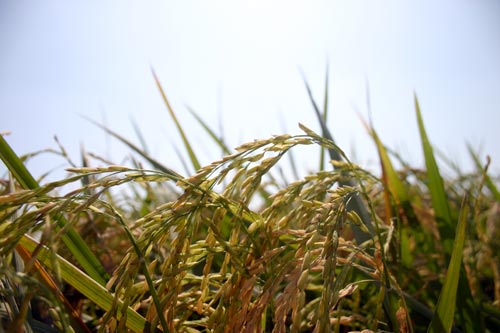May 5, 2011

Water seeding rice into flooded fields can be successful, but it can also be a failure if not done properly. I know it is on the mind of farmers as floodwaters begin to recede.
There are many things to consider before attempting this method. Questions that should be considered are: What is the condition of the seedbed? Can I manage the water properly? Do I have the ability to soak the seed? Will I be able to construct levees in the field? Is there any moving water across the field?
Below are some tips for water seeding rice.
• Seedbed preparation — With water seeding, the seedbed should be in a rougher condition than for dry seeding. A seedbed consisting of primarily large baseball-sized clods is best. A seedbed that has been grooved will also work.
Seed and seedling drifting is often quite severe especially in large, smooth fields. Wind and moving water can also cause seed movement. Seed tends to float to pot holes, drains and low areas.
• Pre-sprouting seed — Pre-sprouting is done by soaking seed for 24 to 36 hours followed by draining for 24 to 36 hours. The seed must be planted shortly after pre-sprouting. Treated rice seeds should not be pre-sprouted or used for water seeding.
Pre-sprouted seed offers the advantage of higher seed weight and initiation of germination because the seed has already imbibed water. Injury from rice seed midge can be severe especially when seeding dry seed.
• Seeding rate — The seeding rate generally should be increased by 30 percent over conventional drill-seeded rice. However, a stand can be established at lower rates if all conditions are ideal.
• Peg down — After seeding with pre-sprouted seed, the field should be drained briefly. The initial drain period is long enough to allow the radical to penetrate the soil (peg down) and anchor the seedling. A three- to five-day drain period is sufficient under normal conditions.
This is a tricky time. The field can be drained immediately after seeding or allowed to be flooded for a few days. This is largely dependent upon temperature. The seed becomes more buoyant during this period and is subject to drifting. The soil should remain saturated (muddy) during this period. It is possible to maintain a continuous flood, although stand establishment is most difficult.
• General discussion — Water seeding is most successful in small, zero grade fields where the water level can be lowered or raised quickly as needed. In these type fields there is also no need to ever dry up the field to construct levees.
Weed and insect control can be different in water-seeded fields as well and consideration should be given to this before deciding on water seeding. Every situation is different and what works for one situation may not work in another.
You May Also Like




